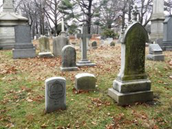
Philip Grandin, son of William Grandin and Amy (Ame) Lewis, was born on October 27, 1792 in New Jersey. He was the brother of Egbert B. Grandin. In 1814, Philip married Amanda Robinson, Gain Robinson’s oldest daughter.
Philip was a collector of taxes in Palmyra and Wayne County. His wife Amanda sang in the Western Presbyterian Church choir. In 1817, Philip was granted a deed from Gain Robinson, his father-in-law.[1] On August 5, 1817, Barnabus Robinson and John Blin of Palmyra sold to Philip acreage in Palmyra located on the south bank of Mud Creek extending eastward to the grist mill owned by Seymour Scovell.[2]
Two years later in 1819, Philip was granted a deed from Deliverance Parshall, Israel Parshall Jr., and Enos Sanford.[3] On December 13, 1819, a co-partnership was founded between Seymour Scovell and Philip under the name of “S. Scovell and Company.” It was later dissolved by mutual consent. All persons indebted to the firm were requested to call and make immediate payment without delay. The partners accepted wheat, rye, pork, etc. as payment. Seymour Scovell announced that he would continue the business on his own.[4]
Philip Grandin was listed in the 1820 US Federal Census as having a household that consisted of one male under age 10, two males ages 18-26, one male age 26-45, one female under age 10, and three females ages 16-26. In 1822, Philip was listed as paying a Palmyra Highway Tax. In fall of 1828, Philip, along with Joel and Levi Thayer, constructed the Thayer & Grandin Row. A portion of the building was rented to E. B. Grandin.
On April 18, 1829, Philip wrote a letter to Luther Bradish.[5] That year, Philip was the first Erie Canal Collector in Palmyra. He collected $53,778 in 1829. On June 18, 1830, a meeting was held to discuss the feasibility of a Wayne County Bank. Philip was selected as a director of the bank along with George Beckwith, Pliny Sexton, Nathaniel H. Beckwith, and Thomas Rogers II.[6] On December 4, 1833, Philip signed the “Testimony of 51 Neighbors,” later printed in Mormonism Unvailed.[7]
From 1839 to 1840, Philip Grandin lived in Manhattan, New York. He was an agent for the American Transportation Company.[8] In 1853, his name appeared on a list of Democratic office holders as a store keeper with a salary of $1,000. At the time, he was connected with the New York Custom House.[9] By 1855, he was living in Brooklyn. Philip died on December 5, 1862 in Brooklyn. He was buried in Section 74, Lot 6101 in the Green-Wood Cemetery in Brooklyn.
[1] Ontario County, NY Grantee Deed Index, 1789–1845.
[2] “Mortgage Sales,” Palmyra Register, February 10, 1819.
[3] Ontario County, NY Grantee Deed Index, 1789–1845.
[4] “Dissolution,” Palmyra Register, December 14, 1819.
[5] Philip Grandin to Luther Bradish, April 1829, in New York Historical Society, New York City, NY.
[6] Ontario County, NY Grantee Deed Index, 1789–1845.
[7] Howe, Mormonism Unvailed, pp. 366–367.
[8] Manhattan, New York Directory 1839–1840.
[9] “The New York Custom House,” New York Times [New York City], February 25, 1853.
